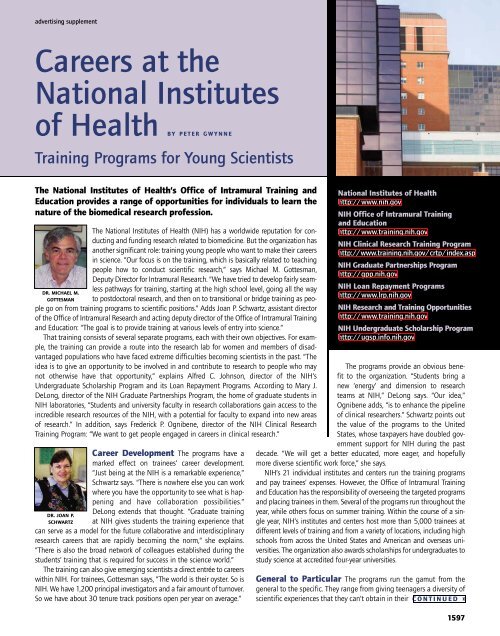THIS WEEK IN
THIS WEEK IN
THIS WEEK IN
You also want an ePaper? Increase the reach of your titles
YUMPU automatically turns print PDFs into web optimized ePapers that Google loves.
advertising supplement<br />
Careers at the<br />
National Institutes<br />
of Health BY PETER GWYNNE<br />
Training Programs for Young Scientists<br />
The National Institutes of Health’s Office of Intramural Training and<br />
Education provides a range of opportunities for individuals to learn the<br />
nature of the biomedical research profession.<br />
dr. michael m.<br />
gottesman<br />
The National Institutes of Health (NIH) has a worldwide reputation for conducting<br />
and funding research related to biomedicine. But the organization has<br />
another significant role: training young people who want to make their careers<br />
in science. “Our focus is on the training, which is basically related to teaching<br />
people how to conduct scientific research,” says Michael M. Gottesman,<br />
Deputy Director for Intramural Research. “We have tried to develop fairly seamless<br />
pathways for training, starting at the high school level, going all the way<br />
to postdoctoral research, and then on to transitional or bridge training as people<br />
go on from training programs to scientific positions.” Adds Joan P. Schwartz, assistant director<br />
of the Office of Intramural Research and acting deputy director of the Office of Intramural Training<br />
and Education: “The goal is to provide training at various levels of entry into science.”<br />
That training consists of several separate programs, each with their own objectives. For example,<br />
the training can provide a route into the research lab for women and members of disadvantaged<br />
populations who have faced extreme difficulties becoming scientists in the past. “The<br />
idea is to give an opportunity to be involved in and contribute to research to people who may<br />
not otherwise have that opportunity,” explains Alfred C. Johnson, director of the NIH’s<br />
Undergraduate Scholarship Program and its Loan Repayment Programs. According to Mary J.<br />
DeLong, director of the NIH Graduate Partnerships Program, the home of graduate students in<br />
NIH laboratories, “Students and university faculty in research collaborations gain access to the<br />
incredible research resources of the NIH, with a potential for faculty to expand into new areas<br />
of research.” In addition, says Frederick P. Ognibene, director of the NIH Clinical Research<br />
Training Program: “We want to get people engaged in careers in clinical research.”<br />
dr. joan p.<br />
schwartz<br />
Career Development The programs have a<br />
marked effect on trainees’ career development.<br />
“Just being at the NIH is a remarkable experience,”<br />
Schwartz says. “There is nowhere else you can work<br />
where you have the opportunity to see what is happening<br />
and have collaboration possibilities.”<br />
DeLong extends that thought. “Graduate training<br />
at NIH gives students the training experience that<br />
can serve as a model for the future collaborative and interdisciplinary<br />
research careers that are rapidly becoming the norm,” she explains.<br />
“There is also the broad network of colleagues established during the<br />
students’ training that is required for success in the science world.”<br />
The training can also give emerging scientists a direct entrée to careers<br />
within NIH. For trainees, Gottesman says, “The world is their oyster. So is<br />
NIH. We have 1,200 principal investigators and a fair amount of turnover.<br />
So we have about 30 tenure track positions open per year on average.”<br />
National Institutes of Health<br />
http://www.nih.gov<br />
NIH Office of Intramural Training<br />
and Education<br />
http://www.training.nih.gov<br />
NIH Clinical Research Training Program<br />
http://www.training.nih.gov/crtp/index.asp<br />
NIH Graduate Partnerships Program<br />
http://gpp.nih.gov<br />
NIH Loan Repayment Programs<br />
http://www.lrp.nih.gov<br />
NIH Research and Training Opportunities<br />
http://www.training.nih.gov<br />
NIH Undergraduate Scholarship Program<br />
http://ugsp.info.nih.gov<br />
The programs provide an obvious benefit<br />
to the organization. “Students bring a<br />
new ‘energy’ and dimension to research<br />
teams at NIH,” DeLong says. “Our idea,”<br />
Ognibene adds, “is to enhance the pipeline<br />
of clinical researchers.” Schwartz points out<br />
the value of the programs to the United<br />
States, whose taxpayers have doubled government<br />
support for NIH during the past<br />
decade. “We will get a better educated, more eager, and hopefully<br />
more diverse scientific work force,” she says.<br />
NIH’s 21 individual institutes and centers run the training programs<br />
and pay trainees’ expenses. However, the Office of Intramural Training<br />
and Education has the responsibility of overseeing the targeted programs<br />
and placing trainees in them. Several of the programs run throughout the<br />
year, while others focus on summer training. Within the course of a single<br />
year, NIH’s institutes and centers host more than 5,000 trainees at<br />
different levels of training and from a variety of locations, including high<br />
schools from across the United States and American and overseas universities.<br />
The organization also awards scholarships for undergraduates to<br />
study science at accredited four-year universities.<br />
General to Particular The programs run the gamut from the<br />
general to the specific. They range from giving teenagers a diversity of<br />
scientific experiences that they can’t obtain in their<br />
CONT<strong>IN</strong>UED »<br />
1597
















